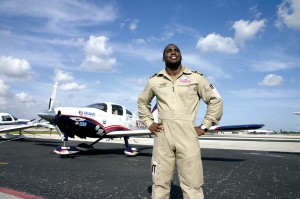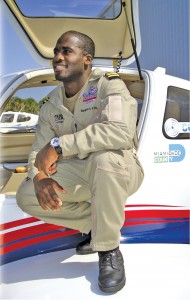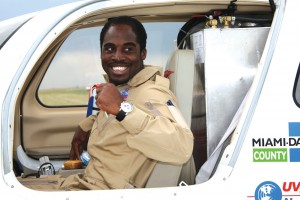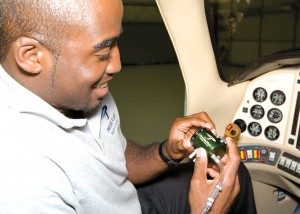
Barrington Irving began his journey at Opa-Locka Airport in Florida, in Inspiration, his groundbreaking Columbia 400.
By Clayton Moore
What’s an imaginative, bright pilot to do after he’s realized his dream of learning to fly? Keep going, of course. That’s exactly what 23-year-old Barrington Irving Jr. chose to do after raising himself up from an underprivileged upbringing in inner-city Miami: to carve a new path as an unseasoned, confident and uncompromising pilot. Irving astonished the world earlier this summer when he completed a flight around the world, becoming the youngest pilot ever to circumnavigate the globe solo.
His physically demanding and technically challenging journey started on March 23, when Irving set off from Opa-Locka Executive Airport (OPF) in Florida, in a Columbia 400 tricked out for the trip with donated parts. The journey ended 97 days later, when he completed his 26,800-mile mission on June 27. His voyage earned him more than 130 hours of flight time and gave a young man who never expected to see the world the opportunity to visit exotic destinations in Spain, Greece, Egypt, Dubai and the Far East.
Although he’s earned far-reaching praise for his accomplishment, Irving insists that the flight was simply part of his larger plan to boost the profile of Experience Aviation, the acclaimed nonprofit educational organization he founded in 2005 to expose young people to careers in aviation.
“The flight was the element that has propelled the organization to the next level, in terms of exposure,” he said. “No other nonprofit wanted to take a chance on me. I basically said, ‘To hell with it. I’m going to do it on my own.'”
Two years after Irving launched his entrepreneurial venture, he finds himself splashed across the front pages of newspapers, featured on “NBC Nightly News” and taking daily phone calls from journalists at the BBC and other international news organizations.
“It’s been crazy since I got back,” Irving admitted a month after returning from his around-the-world flight. “It’s definitely given me a new appreciation for life and what can happen when people come together.”
A timely friendship
Irving was born on Nov. 11, 1983, in Kingston, Jamaica. When he was 6 years old, his father, Rev. Barrington Irving, and his mother Clover moved to Miami, bringing young Barrington into a new and sometimes harsh American landscape.
“It was pretty tough and I saw a lot of bad things,” he admitted, remembering the city streets where he grew up. “I was very fortunate to have both my parents there. They kept me very levelheaded and disciplined. That played a key part in the fact that I stayed off the streets.”
Irving is a man of faith, and the spiritual values instilled in him by his parents and church also helped ease his troubles during trying times.
“Faith played a strong part in my life,” he said. “It instilled a confidence that really helped me during the flight.”

Barrington Irving made his historic flight around the world in a Columbia 400 with over $300,000 in donated equipment. The plane’s manufacturer specially assembled the aircraft for the trip.
His enterprising nature is, to some degree, inherited. Soon after the move to Miami, Irving’s parents opened up a Christian bookstore, where Barrington would work after school.
“I got my entrepreneurial spirit from my parents,” he said. “There were a lot of times when everybody else in the world was out shopping for Christmas or taking time off, and my mother, father, two younger brothers and I were in the store. Although it took away from a lot of family time, it showed the value of hard work, which propelled me forward in the future.”
It was in that very bookstore where Irving’s life took a dramatic turn for the better. One day while stocking shelves, a personable black man in a smart pilot’s uniform struck up a conversation with Irving. He asked the bashful youth if he had ever thought about becoming a pilot.
“Honestly, I feel as if aviation chose me in that moment,” Irving recalled. “No one else in my family is a pilot or has anything to do with aviation. I thought planes were cool, but I never thought I was smart enough to fly an aircraft. Capt. Gary Robinson approached me, almost out of the blue. That was my first time seeing a black pilot.”
Robinson, who also hails from Jamaica, talked to Irving about his job flying the Boeing 777 for United Airlines. The boy was hooked. Soon Irving was touring the Jumbo Jet with his new mentor; the experience still inspires Irving’s work with youth.
“At first I wondered what he wanted from me, but he was just reaching out, as he always does, in a simple act of kindness,” Irving remembered. “My life was changed from the first moment I met Capt. Robinson; it led me to get my pilot’s license and to receive a scholarship to attend college. I remembered how simple his approach was with me. He didn’t have a PowerPoint presentation or a marketing kit. He simply took the time to share information with me.”
To fuel his new passion for flying, Irving practiced every night on Microsoft Flight Simulator, a software program he still uses in planning and practicing flying. Now Microsoft is a sponsor of his efforts and record-breaking flight.
“When I couldn’t afford to fly, that’s what I used to teach myself,” he said. “I definitely used it to a large degree during my instrument training.”
After he graduated from Miami Northwestern Senior High, most of his friends and relatives expected Irving to take one of the numerous football scholarships offered and attend college immediately. Instead, he approached education on his own terms. He started hanging around Opa-Locka Airport, washing planes and earning scholarships to pay for flying lessons and ultimately, his private pilot’s license. He also started volunteering to talk to schoolchildren about becoming a pilot.
“Even though it was just a private pilot’s license, I always really liked it when they would take interest in the story of aviation,” he said. “I never knew that the director of the aviation program at Florida Memorial University was watching me the whole time. He offered me a full scholarship, which paid for the aeronautical sciences degree I’m working towards.”
But the enterprising young scholar had another accomplishment to finish first.
Experience Aviation
In 2005, Irving founded a nonprofit organization, Experience Aviation, Inc., which directly ties in with his personal mission to educate youth. Launched with a $10,000 grant from Miami-Dade Empowerment Trust, Irving has built the Experience Aviation Learning Center at the Opa-Locka Airport facility of Miami Executive Aviation, one of his A-list sponsors. The facility offers tours of aircraft, flight simulators embedded in futuristic HotSeats gaming chairs, and math, science and reading exercises that teach students the real-life value of education.
“I formed Experience Aviation to address the shortage of youth in the aviation industry,” Irving explained. “The average age of an aviation engineer is 54 years old. The organization’s first mission is to inspire and to introduce careers in aviation to students.”
The center’s programs also include “Get a Life & Fly,” a scholarship program designed by Irving and his sponsors to allow disadvantaged high school students the opportunity to earn pilot’s licenses at the age of 17. Another program, the “Career Day Experience,” gives 20 students the opportunity to fly on a simulator, conduct aerodynamic, navigational, engineering and career placement exercises, visit a local aviation business or institution and talk about their experiences.
This fall, riding the momentum that Irving generated from his flight, Experience Aviation hopes to raise funds from much-appreciated corporate and personal donations to the Learning Center and give it a 21st-century face-lift in order to help even more students.
“We’re getting ready for the fall to help schools and launch new programs,” Irving said. “It’s just the logical continuation of how everything fell into place in my life and working hard to get it done. Many kids across this country are suffering. It’s my duty to try to do something about it.”
In fact, the flight was an outgrowth of that drive to inspire others. Little did Irving know that children and teens from all around the world would soon be watching his journey via the wonders of the Internet, with some even replicating his flight on their own copies of Microsoft Flight Simulator.
His dream of a groundbreaking flight began in 2003, with a simple question.
Preparations
“Man, what if I flew around the world?” Irving asked himself, when he was just a 20-year-old pilot with a flight ticket and a bold imagination. It turns out that flying around the globe takes a lot more time, effort, money and expertise than he originally thought.

Barrington Irving greets fans at the Rocky Mountain EAA Regional Fly-In at Denver’s Front Range Airport on June 23.
“I spent a year doing research on other pilots who had flown around the world and the various aircrafts they had used to make the voyage,” Irving remembered. “I spent quite a bit of time researching before I told anybody about it. I thought it would be a great idea. It turned out that a lot of people didn’t see it that way. They thought I didn’t have enough experience.”
Irving turned to some very big names in his search for inspiration. He’s long been inspired by the Tuskegee Airmen and counts among his mentors Erik Lindbergh, who in 2002 recreated Charles Lindbergh’s historic flight across the Atlantic; Dick Rutan, the first person to fly around the world nonstop; and adventurer Steve Fossett.
The biggest challenge in advance of the flight was fundraising, which can be a harrying experience even for the most sophisticated organizations. But Irving rose to the challenge.
“At first, when I started soliciting companies, I got tons of rejection letters and would throw them away,” he said. “I finally said to myself, ‘I’m going to save them and prove them all wrong.’ It’s pretty amazing when you look back.”
When asking several manufacturers if he could borrow or lease a plane for his flight, Irving hit a substantial wall of rejection. Finally, Seamech International, Inc. of Bellaire, Texas, donated a Columbia 400 for the trip. The plane’s manufacturer, Columbia, based in Bend, Ore., agreed to assemble the aircraft and configure it for his trip—but only if he could wrangle up the parts.
For the next year, Irving visited air shows around the country and held high-level meetings with the management of dozens of aviation part manufacturers. The result was the donation of more than $300,000 in components from manufacturers like Teledyne Continental Motors, Goodyear, Kelly Aerospace and Avidyne. Other sponsors include the Tuskegee Airmen, major corporations like Chevron and ExxonMobil and several civic organizations in Miami.
“The Columbia 400 provided me the greatest capabilities as far as altitude, efficiency and fuel conservation,” Irving said. “It’s a manufactured aircraft; there’s really nothing special about it. You just stay within the limits of the plane and fly when the conditions are right.”
As the aircraft, which Irving appropriately named Inspiration, was being assembled, he started training for the difficult flight.
“I had to focus,” he said. “People were definitely concerned about me. I told my family and all my sponsors that I was capable of completing this flight. As long as I stayed within my limits as a pilot and within the limits of the aircraft, I’d be fine. That’s what I did. The flight took two months longer than I expected, but that’s part of learning patience.”
In addition to intensive flight and instrument training, Irving also practiced endurance exercises and experienced flying in real-life conditions. He flew over the open ocean to Jamaica, and experienced a somewhat tense encounter with air traffic control over the embargoed island of Cuba. He also flew to Cartagena, Columbia, where he practiced flying in mountainous terrain.
He was as prepared as nearly any pilot in the world could be for the flight. But any flight can have surprises.
An epic journey
Inspiration took to the air from Opa-Locka Airport on March 23, heading west to Cleveland and up to New York before continuing into Canada. One of the more challenging legs came on April 7, when he flew more than 1,300 miles from St. John’s, Canada, to the Azores.
“It’s hard crossing the ocean that time of year, with the clash between the hot and cold air,” he said. “It’s pretty much IFR all the time during that kind of weather. But the plane provided great fuel economy from its Continental engines. Crossing the Atlantic, I probably burned half a quart of oil during the nine-hour flight.”
He continued his journey through April and visited cities like Madrid, Spain, and viewed the Coliseum in Rome and the Parthenon in Athens, Greece. In Cairo, he flew over the Nile River Valley and the Great Pyramids.
Irving also took time to visit businesses, organizations and flight authorities in different countries to augment his experience.
“It was one of my personal goals,” Irving said. “I think the greatest thing any student, or anyone in any profession, can do is understand their industry and how it works. I didn’t have a great understanding of how aviation works on an international scale. This flight allowed me to get a glimpse of that complexity. I’m better able to talk to students about choosing different careers in aviation because of that experience.”
On May 9, after landing in Dubai, the capital of the United Arab Emirates, Irving started to feel the flight’s physical toll. In addition to the task of piloting the plane, Irving also had to plan his next leg, meet crowds of admirers and create blog postings for his website. Loneliness and the frustrations of weather-related impediments didn’t help, and the pilot lost nearly 15 pounds during the course of his travels.

Barrington Irving holds up his Precise Flow Oxygen conserver made by Precise Flight. Hundreds of manufacturers including Precise Flight, Goodyear, Avidyne and Teledyne Continental Motors donated components to Irving’s plane.
“My body really started to feel the jet lag,” he remembered. “You’re losing time flying that much. To fly for seven hours, talk to the people coming to the airport, try to get fuel and look at the weather is hard. I wasn’t able to get to bed until at least midnight, and then I would wake up at 4 a.m. to fly.”
Irving summoned his inner strength and soldiered on despite his fatigue. He passed through Bangkok, Thailand, and Hong Kong before moving on at the end of May to spend two weeks in Japan, a long stretch punctuated by foul flying weather. On June 9, he started the long 12-hour journey from northern Japan to Shemya, Alaska, a flight of more than 1,500 nautical miles. The passage was turbulent, and Irving related the bumpy ride on his website.
“I know many of you are wondering about my experience crossing the treacherous North Pacific—I assure you it was a challenge,” he wrote on June 17. “I saw cloud formations I’d never seen in my life and saw winds shift from almost every direction, gusting up to 80 knots (92 miles per hour) . The same thing happened on this flight as on my North Atlantic crossing—God opened up a window between two low pressure storm systems. Visibility was very poor, and the ride was a bit turbulent, but there was just enough visibility for me to land at Shemya.”
Back in America, Irving made stops in Seattle, at Denver’s Front Range Airport (FTG) for the Rocky Mountain EAA Regional Fly-In, Houston, and Mobile, Ala., before completing his mission on June 27. Hundreds of people, including Irving’s parents, his brothers Christopher and Ricardo and his good friend Robinson were on hand at Opa-Locka to greet the returning hero. Flashbulb-popping photographers, youth drummers, vocal church leaders and a water salute from two fire trucks added to the cacophony.
“It was crazy,” Irving said. “I never imagined it would be as frenzied as it was. The media’s very enthusiastic about the flight. It’s a great story that will stand on its own, about how people came together for a common cause.”
He told the crowd that he had been frustrated at times, but at the end of the emotional speech, Irving revealed how glad he was to be home, having lived out his dream.
Forward motion
For now, it’s back to work and back to school for Irving, who will press forward both with his university schooling and his efforts to promote Experience Aviation.
“I see it like this: As long as I keep following my passion for working with kids and being true to myself, I’ll be fine,” he said. “If you look at the greats, from Einstein to Burt Rutan, they kept it simple and developed great ideas. I try to follow that example.”
Irving will document the flight from his unique perspective in a book about his experiences and a documentary is planned to chronicle his hurdles and triumphs during the round-the-world flight. Thinking long-term, he wants Experience Aviation to expand its reach, and plans to build a solid business for himself in the aviation industry, based on one of his many percolating ideas.
“The flight will probably be the most boring thing I ever do,” Irving laughs. “We’re going to get students working together to get more aviation education initiatives out there.”
First, Irving and his team will continue fundraising for their noble efforts, as well as to pay down the nearly $1 million cost of the historic flight.
“Because of the delays that occurred during the flight, we do owe some money,” he said. “We’re trying to fundraise for that issue. The other problem is that many school districts across the country want me to come speak, but they can’t afford the transportation. We’re trying to get a little further out there to talk to more students.”
Irving is confident his voice is being heard, and that the real value of his story may not yet be known.
“Students are able to relate to me because of my age,” he said. “Coming back here to Miami, the little knuckleheads are always coming up to me and hanging around the house. It’s hard to put a price on anyone’s life. I don’t know who these programs will reach. Is there a kid out there contemplating joining a gang or worse, who might be moved by our story?”
Irving’s journey, like all great tales of adventure, will endure because it rings true. For his part, all he feels right now is exhausted gratitude.
“It’s not about me,” he said. “You know what? After flying around the world and seeing the amazing things I’ve seen, you’re just grateful for what you have. I thank everybody for all the love and support. It helped me get home.”
For more information about Barrington Irving and Experience Aviation, visit [http://www.experienceaviation.org].











